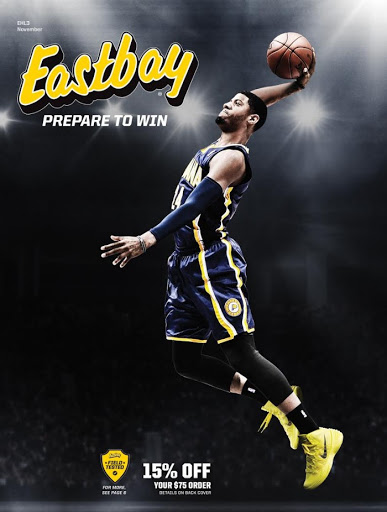 Eastbay, the Wisconsin-based athletic shoe brand owned by Foot Locker, has always operated under its vision to be the go-to resources for pro-grade gear. In pursuing that mission, they are always on the lookout for anything that provides an “edge” – either to their customers, their team or their own success as a brand.
Eastbay, the Wisconsin-based athletic shoe brand owned by Foot Locker, has always operated under its vision to be the go-to resources for pro-grade gear. In pursuing that mission, they are always on the lookout for anything that provides an “edge” – either to their customers, their team or their own success as a brand.
So they wondered – can the paper stock we use for our direct mail catalogs make a difference?
“We only feature a small percentage of what we have available online,” said Eastbay’s senior manager of direct mail about their catalog in a printed report about the case study. “So the goal is to use the catalog as a device to get customers online and shopping.”
The company takes a very modern approach to catalogs, using them for inspirational storytelling and lifestyle portrayal, not product listings. Their stated goal is to get shoppers online by engaging them with maybe one product in the catalog. Once there, they’ll have two or maybe three more products in their cart by the time they check out.
“That’s the power of print,” they noted.
Print has power, certainly. But what about the power of the paper you choose? Can the paper stock make any appreciable difference in ROI? Eastbay decided to test the theory by producing a version of their catalog on higher quality paper, in partnership with specialty paper producer Verso.
“Would a brighter white sheet and more substantial weight contribute to higher perceived value by the customer and drive better sales performance?”
The catalog was printed and mailed to a random sampling of both current customers and prospects. The data showed little measurable difference when mailed to current customers or people already familiar with the brand, but the “new prospect” group was an entirely different story.
The results were startling: Prospects who received the upgraded catalogs printed on higher-quality paper showed a 38% higher response rate, and a 29.9% higher average order value.
Overall the upgraded campaign saw a remarkable 79.9% increase in dollar value per book.
“Those were the results that really jumped off the page,” said the marketing exec. “The lift in response and dollar per book took our cost per new customer down to less than a third of what we spent on the control group. That means ultimately, we’re going to get our money back the next time we get an order from those people. We love those kinds of results.”
I can see why. New customer acquisition is a pricey business. Finding a strategy as seemingly simple as upgrading your paper to dramatically improve results is great for your budget and relatively easy to implement.
Quality matters when you’re reaching out to new prospects (they are basically “blank slates” when it comes to their impression of your brand). A high-quality first impression through a quality catalog leads to higher engagement, more sales and more profit per book.
As Verso says, “Great paper builds great brands.”
I couldn’t agree more.
